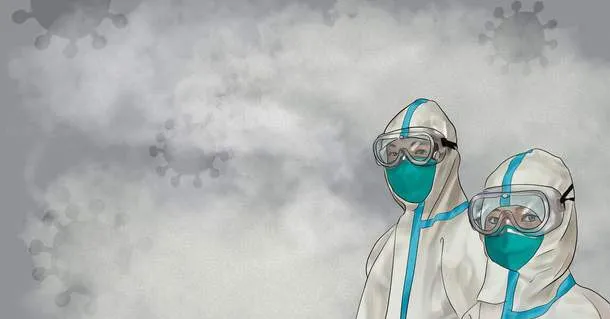Doctor science popularization pneumonia: in-depth analysis, how do the causative factors enter the human body and cause pneumonia?
1 pneumonia
Pneumonia is an acute inflammation of the lung parenchyma and is the most common infectious disease in clinical practice. According to the anatomical classification, it can be divided into lobular, pulmonary segment, lobular and interstitial pneumonia; According to the etiological classification, it can be divided into bacterial, viral, mycoplasma, chlamydia, rickettsial, fungal and protozoal pneumonia, of which bacterial pneumonia is the most common. Toxic pneumonia, also known as shock pneumonia, is a severe bacterial pneumonia with peripheral circulatory failure as its main manifestation, accounting for about 8% of pneumonia, with the characteristics of acute onset, severe symptoms, many contradictions in treatment, poor prognosis, and high case fatality rate. The most common bacteria that cause toxic pneumonia are Staphylococcus aureus, Pseudomonas aeruginosa, Pneumococcus pneumoniae, and Pneumococcus. It is commonly induced during the cold season or during climate change.
. 1
Causes and pathogenesis
A virus or bacteria that causes acute inflammation of the upper respiratory tract can spread to cause the disease. Common pathogenic bacteria are Haemophilus pneumococcal influenzae, streptococcus, and staphylococcus, often secondary to bacterial infection on the basis of viral infection. Physical and academic stimuli such as supercooled air, dust, certain irritating gases, etc., are prone to the disease. Allergies to bacteria, proteins, or cold air can also occur. Parasites such as hookworms, roundworms and other larvae can also cause bronchial infections when the lungs move. Children with recurrent acute tracheo-bronchitis should be ruled out of the possibility of rare diseases such as cystic fibrosis or hypoimmunoglobulinemia.
2.
Characteristics of acute bronchitis
The onset is more acute, often preceded by symptoms of acute upper respiratory tract infection, such as nasal congestion, sneezing, sore throat, hoarseness, etc. Constitutional symptoms are mild, with only mild chills, fever, headache, and general aches. The cough begins to be non-heavy, irritating, with less sputum. After 1-2 days the cough intensifies and the sputum turns from mucus to mucinulous purulent. Mild cases often change in the position of waking up in the morning and sleeping late, and there is a paroxysmal cough after cold air or physical activity; Sometimes even cough all day long. When accompanied by bronchospasm, shortness of breath of varying degrees may occur, with a feeling of posterior sternal tightening. Physical examination of the two lungs breath sounds thickened, scattered in dry, wet beeps. The site of drinking is often not constant, and sputum production can be reduced or disappeared after coughing up. Acute tracheobronchiitis is generally self-limiting, with fever and general malaise resolving in 3 to 5 days, and cough sometimes prolonged for several weeks. If it does not heal, it can evolve into chronic bronchitis over time.
3.
Laboratory tests:
There is no significant change in the blood white blood cell count. When secondary infection is severe, white blood cells may be elevated. Pathogenic bacteria may be detected on sputum smears or cultures. Chest x-ray is mostly normal or the lung texture is thickened.
4.
To distinguish the disease
This disease should be distinguished from the following diseases: (1) Influenza: systemic symptoms are more pronounced, fever, headache and surrounding soreness are more pronounced; The number of white blood cells decreases. Correct identification, based on virus isolation and serological testing during the epidemic season. (2) Acute upper respiratory tract infection: nasopharyngeal symptoms are more obvious, generally no cough, sputum, no abnormal signs in the lungs (8) bronchopneumonia, tuberculosis, lung cancer, lung abscess, measles, pertussis and other lung diseases can be accompanied by acute bronchial diseases
Symptoms of osteitis should be examined in detail to differentiate.
5.
How to treat
1 Symptomatic treatment should be appropriate when there are systemic symptoms should be appropriate rest, pay attention to keep warm, drink more water. Irritating cough should be sucked with hot water, or with normal saline ultrasonic atomization to absorb people; If it is too intense, pentovirine (cough biqing) 25m cough 10 mg or codeine 15-30 mg orally 3 times a day. When the sputum is thick and not easy to cough up, 0.30.6 g of chloride money, or 8-16 mg of australoxin (bidhiping) 3-4 times a day. In the presence of wheezing, aminoxicide 0.1 g, terbutaline (boliconyl) 2.5 mg, or salbutamol (salbutamol) 2.4 mg 3 times daily may be taken. High fever can be used with compound aspirin, etc.
Antimicrobial therapy Depending on the severity of the infection, appropriate oral or injectable antimicrobial therapy may be selected
